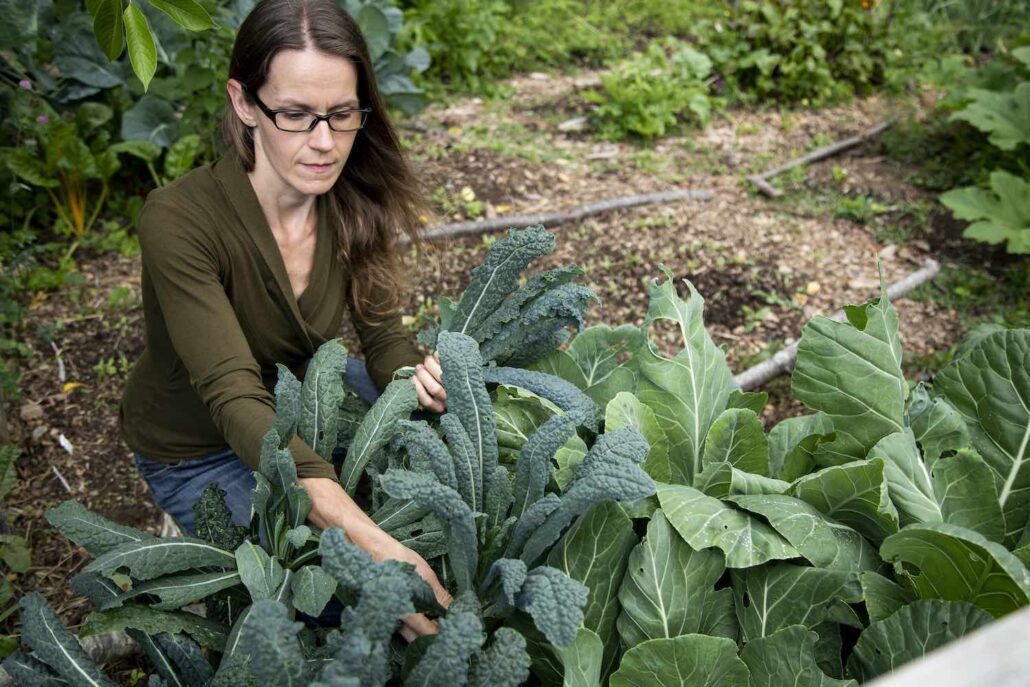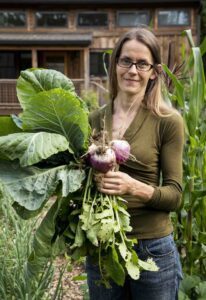Presented by Mother Earth Food
THE FLAVORS OF 50 MILES
How one local woman sources her family’s diet within 50 miles of Asheville
BY MARI JYVÄSJÄRVI STUART | PHOTOS BY ERIN ADAMS
FACE TO FACE WITH YOUR FARMER
The Third Chapter in a Four-Part Series
What happens to you when you begin to source your food locally?
When I first embarked on my local food experiment a year ago, I expected to see some shifts. I thought I would probably see an increase in our family’s monthly spending on groceries and a decrease in our restaurant budget. (Both happened.) I thought I might either lose or gain some weight. (Neither happened.) I knew I’d develop a different relationship to time because a local diet tends to be a slow food diet. I would spend a lot more time in the kitchen setting bread dough to rise, keeping a stock pot simmering, mixing eggs in a volcano of flour to make pasta.
But the most fundamental shift, I found, is this: Eating local food makes you feel more connected to the world around you.
Sourcing food locally creates a visceral sense of connection to the farmers who produced it. You are dependent on them for your sustenance—and that’s not something to be taken lightly. It’s an experience few of us in the modern world get to have. Most of the time, we don’t see the faces of people who grew the food we consume, so standing face to face with your farmers at the tailgate market can be a small revelation. These are people you may not know personally, yet here you are, interconnected in a strangely intimate way because the food they grow feeds your body.
I’ve had moments of feeling overwhelmed with gratitude toward a farmer who grows ginger because her work means I can make a cup of chai, or to the farmer who still sells peaches in late September. “Thank you for growing this crop,” I may say in my understated Finnish way. But what I mean to say is, “You have no idea what this means to me! I’m so excited! I wouldn’t get to enjoy these flavors if it wasn’t for you!” In return, you can be sure I’ll go more than a little out of my way to support these farmers when I can. I want their farms to stay afloat through these challenging times so they can keep doing their good work and enriching our local foodshed.
When one harvest comes to an end, that particular flavor may not be available for another year, but the waiting makes it taste all the more special when it reappears.
 Eating local food also connects us to the seasons. Local eating is, by definition, seasonal eating. Strolling through the produce section at an American supermarket, one would be challenged to guess whether it was May, September or January. No matter what the calendar says, one can always find asparagus, melon, citrus fruit, winter squashes, spring greens in shiny boxes, and strawberries. Contrast that with shopping at a farmers market, opening a weekly CSA box, or growing food in your own garden: One glance at the goods will tell you the season.
Eating local food also connects us to the seasons. Local eating is, by definition, seasonal eating. Strolling through the produce section at an American supermarket, one would be challenged to guess whether it was May, September or January. No matter what the calendar says, one can always find asparagus, melon, citrus fruit, winter squashes, spring greens in shiny boxes, and strawberries. Contrast that with shopping at a farmers market, opening a weekly CSA box, or growing food in your own garden: One glance at the goods will tell you the season.
And the food year is not monotonous. When one harvest comes to an end, that particular flavor may not be available for another year, but the waiting makes it taste all the more special when it reappears. In the meantime, there’s always something else to eat. The bright, tender greens of the early spring give way to hues of purple, red, pink, and blue as early summer brings the first strawberries, blueberries, mulberries, and then raspberries. Late summer is all about bold and warm yellows, oranges, and reds of tomatoes, peppers, squashes, and corn. When fall comes, the contents of the harvest basket are tinted with slightly cooler tones—the deep purples of beets, the grayish greens of cabbages and kale.
Eating seasonal foods synchronizes our bodies and minds with the rhythms and cycles of our environment. It is a truly grounding experience, tethering us in time and space. And sourcing locally links you to the food producers and artisans who are working to rebuild our food systems. Searching for local alternatives to supermarket foods really makes you appreciate the people in our region who are building facilities to mill flour and process nuts, experimenting with new crops or seeking out regional growers for their supply chain, both innovating and preserving tradition out of a passion for food.
Finally, depending on the bounty of nearby farms forges a relationship to the landscape, to the soils of the bioregion in which your food grew. The French word terroir, meaning “taste of place,” refers to the distinctive qualities of a food product that result from the specific soil and environmental conditions of the locale in which it was produced. Terroir is not derived from any single factor but a variety of elements— the minerals in the bedrock beneath a given place, its microclimate, its topography, its water quality, and even the people involved in growing the food product in question. All of this affects the texture, flavor, and aroma of a food or beverage.
Western North Carolina has its own terroir that you can learn to detect. I taste it in the Acornucopia Project’s local black walnuts, in cheeses made from the milk of goats and cows that graze on our region’s pastures, in the apples our family ventures to pick at the orchards in the fall, in the blackberries, pawpaws, and mushrooms that hide in our forests. It’s a profound experience to know that some of the food on your plate—the nourishment that sustains and strengthens your body—comes from these old mountains. The minerals of our soil become a part of you. Frankly, I don’t know a better way to create a sense of place, a sense of home. ◊◊
Mari Stuart is an edible landscape designer, educator, and project manager. A former Humanities professor, she now teaches regenerative design and modern homesteading skills. Mari stewards an urban homestead in Asheville with her family and writes about local food, foraging, gardening, and the connections between people and place at Make Gather Grow.
Save
Save
Save
Save
Save
Save
Save
Save
Save
Save

Mari Jyväsjärvi Stuart
THE WEEKLY REVEL
Sign up for your free handpicked guide to enjoying life around Asheville.
Available weekly from May to October.





